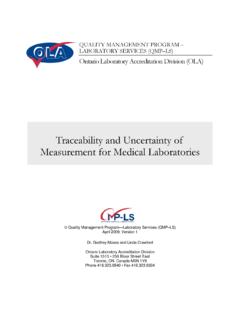Transcription of Quality Standards in Health Laboratories - WHO
1 SEA-HLM-386. Distribution: General Quality Standards in Health Laboratories Implementation in Thailand: A Novel Approach Mayura Kusum*. and Panadda Silva**. * Senior Principal Medical Scientist, Department of Medical Sciences, Ministry of Public Health , Thailand, ** Director, Bureau of Laboratory Quality and Standards , Ministry of Public Health , Thailand, Regional Office for South-East Asia New Delhi World Health Organization This document is not a formal publication of the World Health Organization (WHO), and all rights are reserved by the Organization. The document may, however, be freely reviewed, abstracted, reproduced or translated, in part or in whole, but not for sale or for use in conjunction with commercial purposes. The views expressed in documents by named authors are solely the responsibility of those authors. November 2005. CONTENTS. Page Preface .. vii ix 1. Quality System: Systematic Approach to Ensure Quality .
2 1. Organizational Management and Structure .. 2. Documentation .. 2. Monitoring and 2. Training .. 3. Quality 3. 2. International Organization for Standardization .. 4. 3. Development and Implementation of Standards .. 6. 4. Implementation of National Standards in Thailand: A Novel Approach .. 9. Improvement of Quality Standards .. 9. Partners .. 11. Development of National 12. Standards for Medical Laboratories : 2001 .. 13. Differences between National and ISO Standards .. 21. 5. Conceptual Framework of Implementation .. 23. 6. Implementation Model Adopted in Thailand .. 24. 7. Strategies and Their Implementation .. 27. Establishing Partnerships for Implementation of Work .. 27. Existing Quality System Standards Being Implemented .. 29. Quality System Development Process .. 30. Project Evaluation .. 32. Page iv 8. Project Results .. 33. Participating Hospitals .. 33. Levels of Quality Development Achieved by 33.
3 9. An Assessment of the Participating Units' 37. 10. Lessons 39. Simple Systems are Easy to Implement .. 39. Step-wise Approach Provides a Flexible 39. A Comprehensive Check-list is a Vital Tool .. 40. Different Laboratories are at Different Levels of Quality Development .. 40. Voluntary Participation makes a Good Beginning .. 40. Implementation is Rapid in Medium-sized Hospital Laboratories .. 41. Certain Critical Factors Influencing Quality Development .. 42. Training in Practical Skills is Fundamental to Success .. 42. National Standards can Facilitate Accreditation by ISO .. 43. Enhanced Inter-laboratory Cooperation is an Additional Benefit .. 43. 11. Conclusions .. 44. Page v PREFACE. The importance of Quality in the functioning of Health care Laboratories is well recognized globally; more importantly in developing countries. The poor Quality of laboratory results can lead to inappropriate interventions, adversely affect the credibility of the laboratory and may also invite legal action.
4 It is, hence, essential to develop and implement a policy on Quality in Health Laboratories . The International Organization for Standardization (ISO), has developed Quality systems to assess specific aspects of Health services. A majority of Laboratories rely on International Quality Standards known as ISO/IEC/17025 for all types of testing and calibrating Laboratories and more specifically ISO 15189 for medical Laboratories . These Standards are quite comprehensive and often very resource-intensive. Only a few of the leading Laboratories conform to these Standards , while a majority get discouraged to even attempt meeting the Standards considering the exhaustive list of requirements. This has lead to an all or none situation in many countries. With this background, the importance of developing minimal national Quality Standards for Health Laboratories , which should be mandatorily followed by all Laboratories becomes very important.
5 Achieving international Standards could then follow on an optional and voluntary basis. Thailand has developed and successfully implemented such a model, where national Standards for Health Laboratories have been developed and initially applied on a voluntary basis. A user-friendly 100-point check list of national Standards has been developed which has proved very useful in adoption and self evaluation of the implementation of these Standards . Different Laboratories are at different levels of Quality development and hence a flexible step-wise approach has been Page vii Quality Standards in Health Laboratories followed. The participating Laboratories have cooperated well in implementing this model. The Laboratories have imbibed this model according to their facilities, resources, time-frame and readiness. Above all, this model has significantly enhanced inter- laboratory cooperation. It is hoped that this model will be emulated by other Member States considering its strong fundamentals, and flexible approach to help attain desired laboratory Quality Standards .
6 Doing so would sensitize the Laboratories and facilitate them achieving international Standards in a phased manner on a voluntary basis. The efforts of Dr Mayura Kusum and Dr Panadda Silva from Bureau of Laboratory Quality Standards (BLQS), Nonthaburi, Thailand in developing and successfully implementing the model on National Quality Standards for Health Laboratories and also sharing the concept with the scientific community for its wider applications are gratefully acknowledged. Dr Rattan Lal Ichhpujani, STP/BCT/SEARO has provided valuable technical inputs to enhance the merit of the document. It is sincerely hoped that this publication will achieve its intended objective of stimulating Member States in setting up National Quality Standards for Health Laboratories as a step to achieve International Standards , and to help ensure the Quality of laboratory results. Page viii ABBREVIATIONS. QA Quality Assurance ISO International Organization for Standardization EN 45001 European Norms 45001.
7 ISO/IEC International Organization for Standardization/International Electrotechnical Commission MOPH Ministry of Public Health DMSc Department of Medical Sciences BLQS Bureau of Laboratory Quality Standards EQAS External Quality Assessment Scheme AMTT Association of Medical Technologists of Thailand WHO World Health Organization USCDC United States' Centres for Disease Control SEAMIC Southeast Asian Medical Information Centre IHQIA Institute of Hospital Quality Improvement and Accreditation PT Proficiency Testing EQA External Quality Assessment RMSC Regional Medical Sciences Centres Page ix 1. Quality System: Systematic Approach to Ensure Quality The importance of Quality in the functioning of Health care Laboratories in developing countries has been universally recognized. Laboratories practicing the principles of Quality assurance generate relevant, reliable and cost-effective results. Quality means meeting the Standards .
8 The Standards are pre- determined requirements for a particular substance or service. Quality is of paramount importance in Health Laboratories . Reliable results produced by a laboratory improve the decision making capacity of the clinicians as well as public Health physicians. The consequences of poor Quality could be serious. It could lead to inappropriate action or inaction leading to over treatment, over- investigation or mistreatment, lack of treatment or inadequate investigations. Delayed or suboptimal responses as a result of poor Quality of laboratory services could adversely affect the credibility of the laboratory and may also invite legal action. Quality is ensured through a well defined Quality system which is a part of overall Quality management aimed at ensuring consistency, reproducibility, traceability and efficacy of the products or services. Accordingly, a Quality system is defined as the organizational structure and resources needed to implement Quality requirements.
9 The International Organization for Standardization (ISO) defines a Quality system as the organizational Page 1. Quality Standards in Health Laboratories structure, responsibilities, procedures, processes and resources for implementing Quality management. A Quality system has the following five key elements: Organizational management and structure Documentation Monitoring and Evaluation Training Quality Standards Organizational Management and Structure The overall responsibility for the design, implementation, maintenance and improvements in Quality system rests with the laboratory management. Quality is the responsibility of all the staff members of the organization. Documentation A document is a record whether in printed or electronic version, of any information or instructions including policy statements, Quality manuals, procedures, specifications, calibration tables, reports, job description, documents of external origin such as regulations, Standards and examination procedures etc.
10 Monitoring and Evaluation The laboratory management develops and implements Quality indicators to systematically monitor and evaluate the laboratory's contribution to patient care. When the programme identifies opportunities for improvement within the system, the laboratory management should take appropriate steps to address them. Error management should be vigorously implemented. Page 2. Implementation in Thailand: A Novel Approach Assessment of Quality through audits (internal or external). and participation in external Quality assessment schemes are other tools, the results of which should guide the management in further improving Quality . Training The Quality system is only as good as the staff who actually work for it. No matter how good the Quality system is on paper, if it cannot be translated into practice, Quality cannot be achieved. Training must also include an understanding of why Quality is important.














